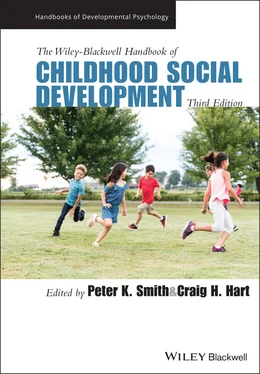190 Tolmie, A. K., Topping, K. J., Christie, D., Donaldson, C., Howe, C., Jessiman, E., Livingston, K., & Thurston, A. (2010). Social effects of collaborative learning in primary schools. Learning and Instruction, 20(3), 177–191.
191 Trickett, P. K., & Putnam, F. W. (1998). Developmental consequences of child sexual abuse. In P. K. Trickett & C. J. Schellenbach (Eds.), Violence against children in the family and the community (pp. 39–56). American Psychological Association.
192 UNESCO. (n.d.). School violence and bullying. UNESCO. https://en.unesco.org/themes/school‐violence‐and‐bullying
193 Vaillancourt, T. (2018). Introduction to the special issue: The neurobiology of peer victimization. Merrill‐Palmer Quarterly, 64, 1–11.
194 Valiente, C., Lemery‐Chalfant, K., & Swanson, J. (2009). Children’s responses to daily social stressors: Relations with parenting, children’s effortful control, and adjustment. Journal of Child Psychology and Psychiatry, 50, 707–717.
195 Vandell, D. L. (2000). Parents, peer groups, and other socializing influences. Developmental Psychology, 36(6), 699–710.
196 Vandell, D. L., Belsky, J., Burchinal, M., Steinberg, L., & Vandergrift, N. (2010). Do effects of early child care extend to age 15 years? Results from the NICHD Study of Early Child Care and Youth Development. Child Development, 81, 737–756.
197 Vandell, D. L., Shernoff, D. J., Pierce, K. M., Bolt, D. M., Dadisman, K., & Brown, B. B. (2005). Activities, engagement, and emotion in after‐school programs (and elsewhere). New Directions for Youth Development, 105, 121–129.
198 Van Lier, P. A. C., & Koot, H. M. (2010). Developmental cascades of peer relations and symptoms of externalizing and internalizing problems from kindergarten to fourth‐grade elementary school. Development and Psychopathology, 22, 569–582.
199 Veenstra, R., Lindenberg, S., Zijlstra, B. J. H., De Winter, A. F., Verhulst, F. C., & Ormel, J. (2007). The dyadic nature of bullying and victimization: Testing a dual‐perspective theory. Child Development, 78, 1843–1854.
200 Vygotsky, L. S. (1978). Mind in society. M. Cole, V. John‐Steiner, S. Scribner, & E. Souberman (Eds.). Harvard University Press.
201 Wachs, T. D. (1983). The use and abuse of environment in behavior‐genetic research. Child Development, 54, 396–407.
202 Walker‐Barnes, C. J., & Mason, C. A. (2001). Ethnic differences in the effect of parenting on gang involvement and gang delinquency: A longitudinal, hierarchical linear modeling perspective. Child Development, 72, 1814–1831.
203 Waters, E., Merrick, S., Treboux, D., Crowell, J., & Albersheim, L., (2000). Attachment security in infancy and early adulthood: A twenty‐year longitudinal study. Child Development, 71, 684–689.
204 Watson, J. B. (1913). Psychology as the behaviorist views it. Psychological Review, 20, 158–177.
205 Wentzel, K. R. (2015). Socialization in school settings. In J. E. Grusec & P. D. Hastings (Eds.), Handbook of socialization: Theory and research (pp. 251–275). Guilford Press.
206 White, S. H. (1994). G. Stanley Hall: From philosophy to developmental psychology. In R. D. Parke, P. A. Ornstein, J. J. Rieser, & C. Zahn‐Waxler (Eds.), A century of developmental psychology (pp. 103–126). American Psychological Association.
207 Wigfield, A., & Eccles, J. S. (1994). Children's competence beliefs, achievement values, and general self‐esteem: change across elementary and middle school. Journal of Early Adolescence, 14, 107–138.
208 Wilson, B. J., Smith, S. L., Kunkel, D., Linz, D. Colvin, C. M., & Donerstein, E. (2002). Violence in children’s television programming: Assessing the risks. Journal of Communication, 52, 5–35.
209 Wolak, J., Mitchell, K. J., & Finkelhor, D. (2006). Online victimization of youth: 5 years later. National Center for Missing and Exploited Children.
210 Wolak, J., Mitchell, K., Wolak J., & Finkelhor, D. (2002). Close online relationships in a national sample of adolescents. Adolescence, 37, 441–455.
211 Wolke, D., & Lereya, S. T. (2015). Long‐term effects of bullying. Archives of Disease in Childhood, 100, 879–888.
212 Ybarra, M. L., Mitchell, K., Wolak J., & Finkelhor, D. (2006). Examining characteristics and associated distress related to internet harassment: Findings from the second youth internet safety survey. Pediatrics, 118(4), e1169–e1177.
213 Zahn‐Waxler, C., Cummings, E. M., McKnew, D. H., & Radke‐Yarrow, M. (1984). Altruism, aggression, and social interactions in young children with a manic‐depressive parent. Child Development, 55, 112–122.
PART II Disciplinary Perspectives
Psychology forms a recognized discipline, and many of the contributors to this volume are developmental psychologists. However, child development is an interdisciplinary area. The Society for Research in Child Development, based in the United States, has an explicitly interdisciplinary membership base. Traditional disciplines (such as psychology) are really no more than convenient labels or packages for organizing study and research, which run a danger of becoming ossified rather than reflecting the dynamic nature of evolving knowledge. The historical context of how the study of child development evolved as a discipline was summarized in Chapter 1, mainly from a psychological perspective. In this section, we examine six different disciplinary perspectives in the area, ranging from the very biological through to the very social. These perspectives enrich the area and provide vital theoretical perspectives and methodological inputs.
Darya Gaysina introduces the approach of behavioral genetics to understanding social development in childhood. She explains the range of concepts and techniques in this area. Although progress is being made in looking at the effects of particular genes, and also particular environmental factors, it is clear that generally such individual effects are small, and it is combinations of various genes and environmental factors that provide more explanatory power. Moving on from molecular genetics, she describes the traditional family‐studies approaches (twin and adoption studies). She then reviews the various kinds of gene‐environment correlations, and of gene‐environment interactions. Her chapter makes it very clear that behavior geneticists are interested in environmental factors as well as genetic factors, and the complex interplay between them.
Erin Bigler provides a neuropsychological perspective, starting with basic information on the stages of development of the human brain, from gestation onwards. This development embraces size, myelination, and connectivity. From the 1970s onwards, studies of the brain have been revolutionised by techniques of computed tomography (CT) and magnetic resonance (MR), and these have become increasingly sophisticated, providing novel methods for studying neuroimaging‐identified networks. His chapter discusses how an injury or adverse event at a critical stage of brain development may affect the brain and social behavior. The picture is far from one of biological determinism, as many perceived and/or experienced adverse levels of environmental stress can be hazards for social brain development.
It is now fairly widely accepted that our evolutionary history provides a vital part of understanding who we are and how we function. For some hundreds of thousands of years our ancestors survived in a hunter‐gatherer lifestyle, sometimes referred to as the environment of evolutionary adaptedness, and this is argued to still have relevance for understanding modern humans. Lance Workman, Sandie Taylor, and Jerome Barkow develop such a perspective on social development, drawing from evolutionary psychology, human behavioral ecology and life history theory—perspectives that feed into evolutionary developmental psychology. They describe the work of earlier theorists in the area, notably Darwin, Hall, Bowlby, and Ainsworth, moving on to more recent theorists including Belsky, Harris, del Guidice, Tomasello, Geary, and Bjorklund. They consider the idea of developmental switch points, including one proposed for the juvenile period around 6–8 years; this can be related to the increasing importance of peers, and the ideas of group socialization theory. Also discussed is the development of social cognition; and three types of developmental adaptations: ontogenetic, deferred, and conditional. They conclude with a discussion of “cultural editing” and how this is changing in contemporary society.
Читать дальше












